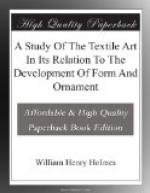It is not to be supposed for a moment that the inception of esthetic notions dates from this association of ideas of beauty with textile characters. Long before textile objects of a high class were made, ideas of an esthetic nature had been entertained by the mind, as, for example, in connection with personal adornment. The skin had been painted, pendants placed about the neck, and bright feathers set in the hair to enhance attractiveness, and it is not difficult to conceive of the transfer of such ideas from purely personal associations to the embellishment of articles intimately associated with the person. No matter, however, what the period or manner of the association of such ideas with the textile art, that association may be taken as the datum point in the development of a great system of decoration whose distinguishing characters are the result of the geometric textile construction.
In amplifying this subject I find it convenient to treat separately the two classes of decorative phenomena—the relieved and the flat—notwithstanding the fact that they are for the most part intimately associated and act together in the accomplishment of a common end.
RELIEF PHENOMENA.
Ordinary features.—The relieved surface characters of fabrics resulting from construction and available for decoration are more or less distinctly perceptible to the eye and to the touch and are susceptible of unlimited variation in detail and arrangement. Such features are familiar to all in the strongly marked ridges of basketry, and much more pleasingly so in the delicate figures of damasks, embroideries, and laces. So long as the figures produced are confined exclusively to the necessary features of unembellished construction, as is the case in very primitive work and in all plain work, the resultant patterns are wholly geometric and by endless repetition of like parts extremely monotonous.
In right angled weaving the figures combine in straight lines, which run parallel or cross at uniform distances and angles. In radiate weaving, as in basketry, the radial lines are crossed in an equally formal manner by concentric lines. In other classes of combination there is an almost equal degree of geometricity.
When, however, with the growth of intelligence and skill it is found that greater variety of effect can be secured by modifying the essential combinations of parts, and that, too, without interfering with constructive perfection or with use, a new and wide field is opened for the developmental tendencies of textile decoration.
Moreover, in addition to the facilities afforded by the necessary elements of construction, there are many extraneous resources of which the textile decorator may freely avail himself. The character of these is such that the results, however varied, harmonize thoroughly with indigenous textile forms.
To make these points quite clear it will be necessary to analyze somewhat closely the character and scope of textile combination and of the resultant and associated phenomena.




